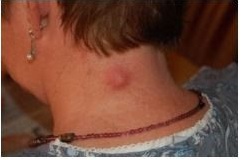

Consultant Plastic and Reconstructive Surgeon

Consultant Plastic and Reconstructive Surgeon

What are epidermoid cysts?
Epidermoid cysts are small, hard lumps that develop under the skin. These cysts are common. They grow slowly. They do not cause other symptoms and are nearly never cancerous. Epidermoid cysts are often found on the face, head, neck, back, or genitals. They can range in size from 1/4 inch to 2 inches across. They look like a small bump, are tan to yellow in colour, and are filled with thick, smelly matter. They do not cause any pain and can usually be ignored.
What causes epidermoid cysts?
Epidermoid cysts are usually caused by a buildup of keratin. Keratin is a protein that occurs naturally in skin cells. Cysts develop when the protein is trapped below the skin because of disruption to the skin or to a hair follicle. These cysts often develop in response to skin trauma, HPV infection, acne, or excessive exposure to the sun. An epidermoid cyst is more likely to develop in people with acne or other skin conditions.
How are epidermoid cysts diagnosed?
Physicians can usually diagnose an epidermoid cyst by examination only, but sometimes an ultrasound is needed to confirm the diagnosis.
How are epidermoid cysts treated?
Most epidermoid cysts either stop growing or go away on their own without treatment. Treatment may be required if the cyst becomes red, swollen, painful, changes in size or character, or is infected. In such cases, treatment options include antibiotics and drainage. Sometimes the cyst may need to be surgically removed. It can also be removed for cosmetic reasons.
What is the outlook for epidermoid cysts?
In most cases, epidermoid cysts cause no long-term problems. Squeezing out the contents of the cyst on your own can lead to infection, so it’s best to leave the cyst alone.
Once a cyst is drained, there is a possibility that it will grow back. Very rarely, epidermoid cysts can become cancerous. Any significant change in a cyst is reason to see your doctor
The operation is performed under local anaesthetic and therefore painless. The area will remain numb for a few hours afterwards. However, once the local anaesthetic has worn off, the wound may feel tender and sore for a few days. Take your normal painkillers regularly to keep yourself comfortable.
■ Driving – You may not drive for 24 hours if you have had a general anaesthetic. There are no driving restrictions if you have had a local anaesthetic.
■ Activities – Avoid contact sports or any activities that may pull on your stitches.
If your wound is stitched and covered with a protective dressing; the stitches may require removal in 5, 7 or 10 days time. The staff will advise you if the stitches need to be removed at an outpatients appointment. Keep your wound clean and dry until your stitches have been removed, or advised by staff.
■ Bleeding – Your wound may bleed a little after the operation. If this occurs, place a clean cotton handkerchief or cloth over the area and apply constant pressure for approximately 10-15 minutes.
■ Infection – Your wound may become infected. If your wound becomes swollen, very red, very tender or starts producing a cloudy discharge, see your GP who may prescribe you antibiotics.
■ Scarring – Any surgery will result in a scar. In most cases, the scar will appear pink to start with and then eventually virtually disappear. However, sometimes the scar may remain visible. It may 3 look a different colour from the surrounding skin or be raised above the surface of the skin. Rarely, the scar may feel numb or even be painful.
■ Recurrence – There is a risk that the cyst sac may not be completely removed, which can result in the cyst returning.
Often, the cysts are small and do not require any treatment at all. They may disappear by themselves. However, if the cyst is large or infected, the treatment options are:
Free video/face to face consultation
with consultant plastic surgeon
Please fill in your details and we will get back to you.